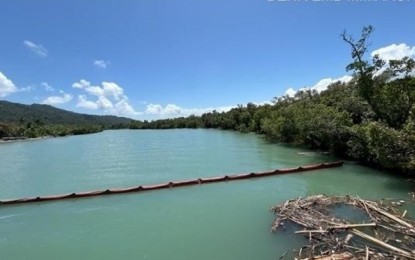
(Photo courtesy of DENR)
MANILA – Oil spill booms have been created and installed by the Department of Environment and Natural Resources as part of effort to contain the oil spill coming from the sunken MT Princess Empress that has affected areas in the MIMAROPA and Western Visayas Regions. MIMAROPA is comprised of the provinces of Oriental and Occidental Mindoro, Marinduque, Romblon and Palawan.
In a press release issued on Tuesday, the DENR said the oil spill booms are made from locally available organic and indigenous materials.
“Booms are temporary floating barriers used to contain marine spills, protect sensitive wetlands, and assist in recovery,” the DENR said.
It added that the trajectory map of the University of the Philippines Marine Science Institute (UPMSI) serves as a guide to installing the booms.
During its presentation at the Senate hearing by the Committee on Environment, Natural Resources and Climate Change, University of the Philippines-Diliman Marine Science Institute Professor Dr. Cesar Villanoy said the UPMSI projected that the oil spill could reach northern Palawan mainland and threaten over 36,000 hectares of marine habitats.
“The main point here is that we really need to stop the seepage from the sunken vessel,” Villanoy said.
Meanwhile, the DENR said the use of improvised spill booms is a feasible precautionary measure to prevent damage to marine environments.
Provisional spill booms made of cogon and sawali have already been installed by the DENR-Environmental Management Bureau (EMB) MIMAROPA, together with the Philippine Coast Guard (PCG) and the local government unit (LGU) in Casiligan River and Calimawawa River in Oriental Mindoro to prevent the oil spill from reaching the mangrove forests, coral reefs, and other marine life.
Coconut shingles, which have effective adsorption capacities, are also vital materials in fabricating spill booms. These are used with nets in Barangay Misong, Pola town, and rice straws in Barangay Aplaya in Poblacion and Barangay Anilao in Bongabong town.
“Coastal municipalities not affected by the oil spill have started fabricating and deploying spill booms two kilometers away from their shorelines as a precaution against the spill,” the DENR said.
The Imalaguan Island Marine Protected Area (MPA) in Cuyo town, Palawan now has about 100-meter booms, protecting its sanctuaries inhabited by pelagic fishes, coral reefs, and mangrove forests. Volunteers in Roxas, Palawan, which caters 13 MPAs across its 11 barangays, also started deploying spill booms.
Meanwhile, the DENR-EMB Western Visayas is working with the local government of Caluya town, Antique and PCG to undertake cleanup operations at the shorelines of Sitio Sabang in Barangay Tinogboc. This included the fabrication and completion of a 1,363-meter improvised spill boom using nets and coconut shingles to help contain the oil spillage and prevent it from reaching the shore.
DENR Secretary Maria Antonia Yulo Loyzaga, meanwhile, assures that they remain vigilant in protecting the country’s environment and natural resources, especially those in the MIMAROPA and Western Visayas regions, whose island provinces are home to hundreds of marine protected areas rich with marine biodiversity, coral cover quality and diversity, and fish composition that have significant value to communities.
“We have plotted out our ways forward which are continuing to evolve because we are assuming the worst will actually happen,” Loyzaga said, adding that “this is a rolling plan that will respond to the conditions on the ground as well to the needs of our affected communities”. (PNA)
